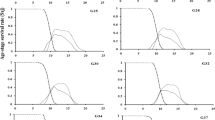Abstract
The egg load of lab-cultured Cotesia marginiventris (Cresson) (Hymenoptera: Braconidae), a solitary koinobiont endoparasitoid of noctuid caterpillars, was determined in this study. Information on egg load may provide clues to more efficient in vivo rearing of C. marginiventris. I tested the hypothesis that egg load, defined as the number of mature oöcytes (i.e., fully chorionated eggs) found in adult females, was related to body size. Cotesia marginiventris females possessed two ovaries and two ovarioles per ovary; mature eggs were found in ovaries and oviducts. Newly-emerged females held an average of 149 mature eggs. Immature eggs were slightly visible in the distal portions of the ovarioles; they were not counted. Egg load was marginally related to body size (i.e., hind tibia length). The results of this study suggest that (1) body size can sometimes predict egg load or potential fecundity of lab-cultured C. marginiventris and (2) an efficient rearing system that exploits the potential fecundity of C. marginiventris might involve using young females and allowing them to oviposit in new hosts, each day, for up to a week.
Similar content being viewed by others

References
Ellers J. and Jervis M.A. (2003). Body size and the timing of egg production in parasitoid wasps. Oikos 102: 164–172
Ellers J. and Jervis M.A. (2004). Why are so few parasitoid wasp species pro-ovigenic?. Evol. Ecol. Res. 6: 993–1002
Flanders S.E. (1942). Oösorption and ovulation in relation to oviposition in the parasitic Hymenoptera. Ann. Entomol. Soc. Am. 35: 251–266
Gillespie, D., G. Opit, R. McGregor, M. Johnston, D. Quiring and M. Foisy, 1997. Recommendations for the use of the parasitic wasp, Cotesia marginiventris, (Hymenoptera: Braconidae) for biological control of cabbage looper, Trichoplusia ni. Pacific Agri-Food Res. Centre (Agassiz), Tech. Rep. 142: 1–2.
Heimpel G.E. and Rosenheim J.A. (1998). Egg limitation of parasitoids: a review of the evidence and a case study. Biol. Control 11: 160–168
Hoňek A. (1993). Intraspecific variation in body size and fecundity in insects: a general relationship. Oikos 66: 483–492
(1999). Reference Guide for Windows, Version 6.0. Media Cybernetics, Silver Spring, MD
Jervis M.A. and Ferns P.N. (2004). The timing of egg maturation in insects: ovigeny index and initial egg load as measures of fitness and of resource allocation. Oikos 107: 449–460
Jervis M.A., Heimpel G.E., Ferns P.N., Harvey J.A. and Kidd N.A.C. (2001). Life-history strategies in parasitoid wasps: a comparative analysis of ‘ovigeny’. J. Anim. Ecol 70: 442–458
Jervis M.A., Ferns P.N. and Heimpel G.E. (2003). Body size and the timing of egg production in parasitoid wasps: a comparative analysis. Funct. Ecol. 17: 375–383
King E.G. and Hartley G.G. (1985). Heliothis virescens. In: Singh, P. and Moore, R.F. (eds) The Handbook of Insect Rearing, pp 323–328. Elsevier, NY
McCutcheon, G.S., 1987. Potential of the parasitoid Cotesia marginiventris as a biocontrol agent of lepidopterous larvae in soybean. Ph. D. dissertation, Univ. Georgia, Athens.
Mills N.J. and Kuhlmann U. (2000). The relationship between egg load and fecundity among Trichogramma parasitoids. Ecol. Entomol. 25: 315–324
Mohaghegh J., Tirry L. and Clercq P. (1999). Effects of rearing history and geographical origin on reproduction and body size of the predator Podisus nigrispinus (Heteroptera: Pentatomidae). Eur. J. Entomol. 96: 69–72
Muesbeck C.F.W. (1921). A revision of the North American species of Ichneumon-flies belonging to the genus Apanteles. U. S. Nat. Mus. Proc. 58: 483–576
Nordlund D.A. (1998). Capacity and quality: keys to success in the mass rearing of biological control agents. Nat. Enemies Ins. 20: 169–179
Novoa M.C. and Luna M.G. (1996). Parasitism, survivorship, sex ratio and developmental time of Cotesia marginiventris (Cresson) (Hymenoptera: Braconidae), parasitizing Rachiplusia nu (Guennée) (Lepidoptera: Noctuidae) larvae in soybean crops in Argentina. Acta Entomol. Chilena 20: 23–28
Olson D.M. and Andow D.A. (1998). Larval crowding and adult nutrition effects on longevity and fecundity of female Trichogramma nubilale Ertle and Davis (Hymenoptera: Trichogrammatidae). Environ. Entomol. 27: 508–514
Quicke D.L.J. (1997). Parasitic Wasps. Chapman and Hall, London
Riddick E.W. (2004). Production of the parasitoid Cotesia marginiventris (Hymenoptera: Braconidae) in unicellular rearing trays using the host Spodoptera exigua (Lepidoptera: Noctuidae). J. Entomol. Sci. 39: 362–372
Riddick E.W. (2005). Egg load of lab-cultured Anaphes iole and effects of mate presence and exposure time on load depletion. BioControl 50: 53–67
Ruberson J.R., Herzog G.A., Lambert W.R. and Lewis W.J. (1994). Management of the beet armyworm (Lepidoptera: Noctuidae) in cotton: role of natural enemies. Fla. Entomol. 77: 440–453
(2004). Getting Started Guide, Version 3.0. SYSTAT Software Inc., Rich- mond, CA
Tillman P.G. (2001). Factors affecting parasitization of Spodoptera exigua (Lepidoptera: Noctuidae) and sex ratio of the parasitoid Cotesia marginiventris (Hymenoptera: Braconidae). J. Entomol. Sci. 36: 188–198
Urbaneja A., Lara L., Timmer R. and Blockmans R. (2002). Utilización de Cotesia marginiventris (Cresson) (Hym.: Braconidae) para el control biológico de orugas (Lep.: Noctuidae) en el manejo integrado de plagas en pimiento bajo invernadero. Bol. San. Veg. Plagas 28: 239–250
Wickman P.-O. and Karlsson B. (1989). Abdomen size, body size and the reproductive effort of insects. Oikos 56: 209–214
Zar J.H. (1999). Biostatistical Analysis. Prentice Hall, NJ
Author information
Authors and Affiliations
Additional information
The United States Government has the right to retain a non-exclusive, royalty-free license in and to any copyright of this article. This article reports the results of research only. Mention of a commercial or proprietary product does not constitute an endorsement of the product by the United States Department of Agriculture.
Rights and permissions
About this article
Cite this article
Riddick, E.W. Egg Load and Body Size of Lab-cultured Cotesia marginiventris . Biocontrol 51, 603–610 (2006). https://doi.org/10.1007/s10526-005-2939-5
Received:
Accepted:
Published:
Issue Date:
DOI: https://doi.org/10.1007/s10526-005-2939-5



